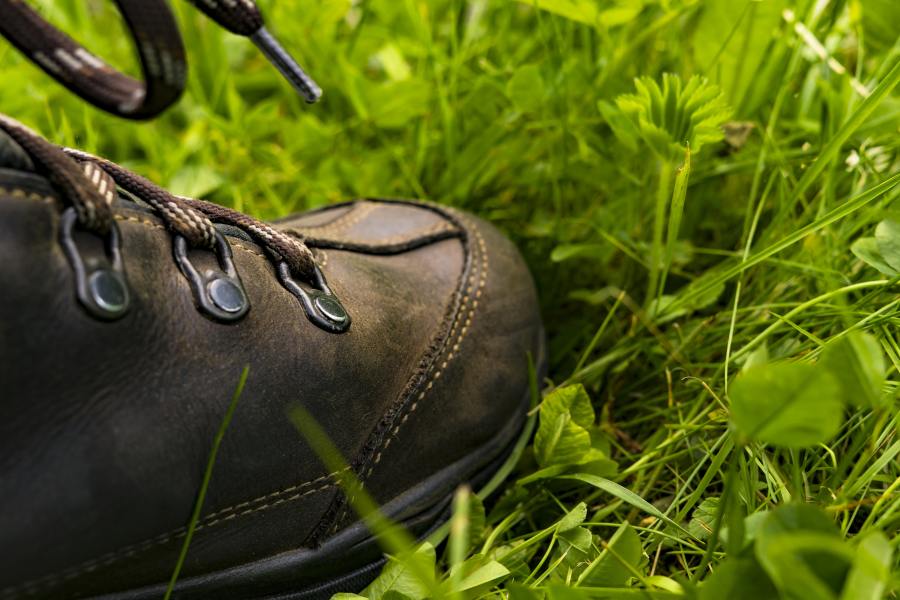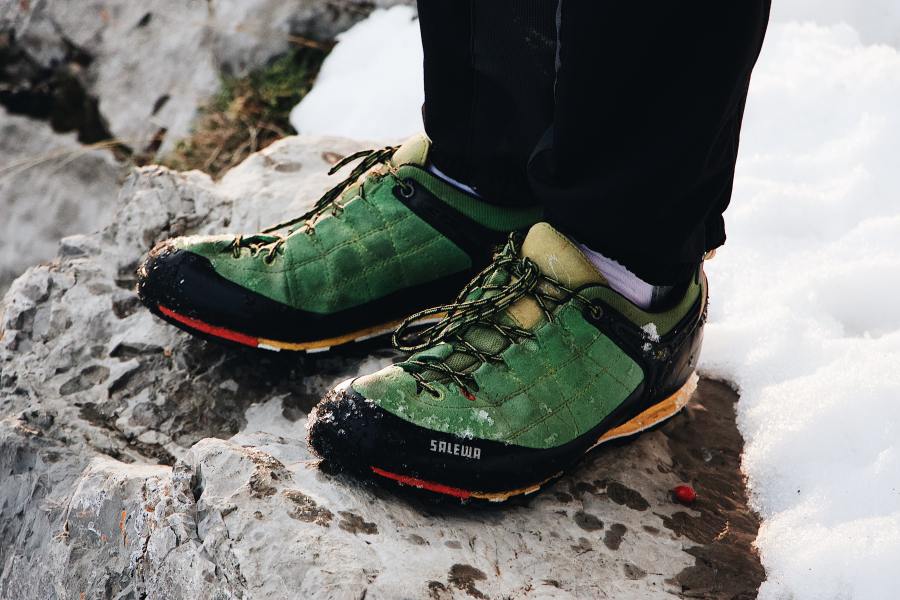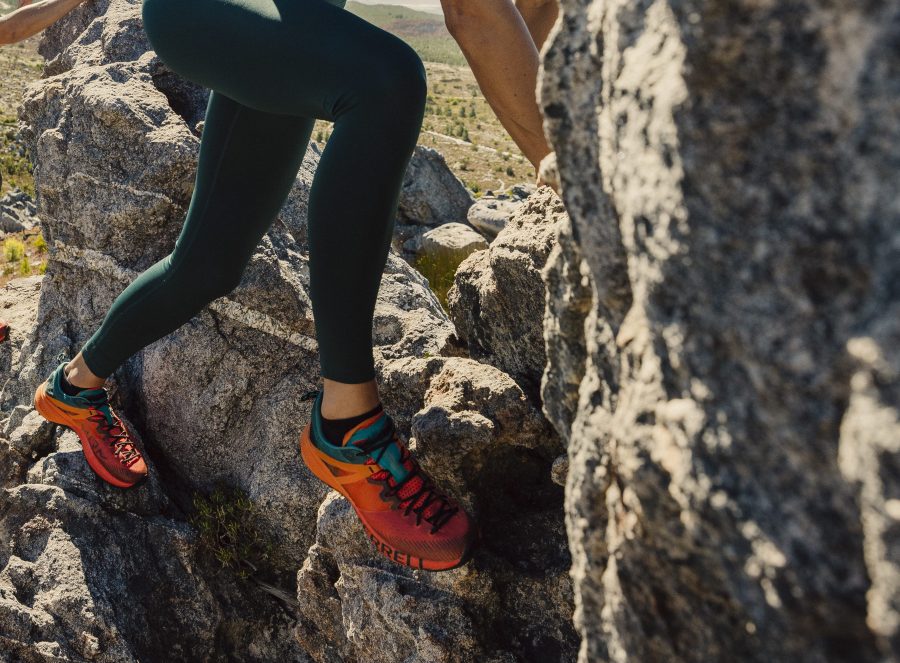With a plethora of outdoor shoes available, what is the difference between trail shoes and hiking boots and which will suit your hikes best?
Many walkers look to use the lightest gear possible to enable longer, quicker and less cumbersome hikes. This applies to footwear just as much as the kit you carry on your back, with hikers and hillwalkers often opting for low, trainer-style hiking shoes rather rather than more ‘traditional’ hiking boots, particularly in the warmer months. But the terminology used to describe these types of shoes can vary – the terms ‘hiking shoes’ and ‘trail shoes’ can often be used to describe fairly similar types of footwear, and the distinction between the two can be confusing. To answer this, we address the difference between trail shoes and hiking shoes.
Words: Francesca Donovan | Main image: Merrell
These differences come down to the main functions and features of the various types of shoe, including weight, support, protection, durability, traction, and breathability. Beyond that, comfort is often down to the shape of your foot and getting a good fit.
Trail shoes vs hiking shoes
Generally speaking, hiking shoes are specifically designed for walkers taking on variable terrain. Trail shoes are usually designed for use on similar terrain, but are primarily aimed to cater to the more nimble footfall of runners – although they are often used by hikers as well.
The distinction between the two types of shoes has become blurrier than ever in recent years. Many manufacturers which are known primarily as running brands understand that their shoes are often used by hikers, and produce product ranges aimed at hiking or ‘fast hiking’ audiences. Similarly, brands which are known mainly for their hiking credentials often recognise that there is a demand for lighter footwear. The result is a lot of ‘hybrid’ products that are pitched somewhere in the middle: trail shoes that also work for hikers, hiking shoes that also work for nimble-footed fastpackers, and so on.
Ultimately, the difference between trail shoes and hiking shoes is found in the key features of the products, and delving into these will help you work out which is best for you.
Weight
Hiking shoes tend to be a little heavier than trail shoes, so ultralight enthusiasts often opt for trail running shoes. While hiking shoes are often similar in composition to a tough hiking boot but cut lower at the ankle, trail shoes or a hybrid shoe can cut weight drastically, making you quicker and more agile. As one enthusiast on team TGO put it: “There’s no need to encase your foot in half a cow anymore.”
But shaving the extra grams does sometimes require compromise.
Durability
This leads us to the next major consideration. Your average hiking shoe is usually more durable than a trail shoe, thanks to its boot-like construction; think thick midsole, stiff materials, and toecaps designed to withstand abrasive terrain. The natural components of leather – the most popular material for a hiking shoe – and the thicker nylons used will likely outlast the thinner nylons of a trail shoe.

Credit: Felix Mittermeier
With that said, durability can be greatly affected by the design, construction and materials used in the manufacturing of the shoe. So a top-grade trail shoe with the right care might end up more durable than a cheap hiking shoe.
Protection
As above, hiking shoes often benefit from many of the protective qualities of a hiking boot. The substantial midsole, outsole, and upper act as an effective barrier between your feet and the terrain and many are made with chunky caps to protect toes. On the other hand, the lightweight flex of a trail shoe often means less in the way of protection.
Both types of shoes ultimately offer less protection than a hiking boot – the extra height offers better coverage and thus protection from the elements and debris. But the protection offered by low-cut footwear can be boosted by a lightweight pair of gaiters.
Support
Likewise, both hiking shoes and trail shoes ultimately offer less protection than a high hiking boot – they just don’t offer the same level of ankle support. But, trail shoes can offer a comfortable fit while retaining the levels of support necessary, depending on your needs. In both hiking and trail shoes, look for ample cushioning and stiffness if you’re concerned about support and always try your options on for size and feel before investing.
Here, The Great Outdoors Gear Editor, Chris Townsend explains how to find your fit in hiking boots and shoes.
Traction and tread
Good traction on rocky and variable terrain is important to both hikers and runners, so in general, both hiking shoes and trail shoes should work well in that respect. Different types of tread materials and patterns can work better on certain types of terrain than others, so it’s worth considering what you’ll mainly be using your shoe for. But in general, the soles of trail shoes tend to offer a greater connection between your foot and the terrain below. The flex allowed here can give much greater comfort and freedom of movement – as well as heightened sensitivity to the trail – when moving quickly, but this can take some getting used to if you’re a hiker more used to the typically thicker soles of hiking shoes.
Breathability
By design, hiking and trail shoes offer a more breathable option than hiking boots, which is part of the reason why many walkers favour them in the warmer months. Of the two types, trail shoes typically win out on breathability due to being made with lighter materials, but if you’re after hiking shoes but are worried about breathability, look for a pair with mesh uppers.
It should be noted that the main factor affecting breathability in both types of shoe, however, is the presence of a waterproof membrane (such as Gore-Tex). This will offer greater protection from the elements, but while some waterproof linings perform better than others in terms of breathability, but a shoe with one will always feel less breathable than a shoe without.
A waterproof lining also becomes redundant if water finds its way over the top of the shoe, which is more likely to happen with trail and hiking shoes, and when it does, a shoe with a waterproof lining will take longer to dry than one without. Ultimately, the decision to go with a waterproof membrane or not comes down to factors like personal preference and the likely conditions and terrain you’ll face.

A climber picking through the snow.
Credit: Maël Balland
So what shoes should I wear?
Ultimately, the decision comes down to weighing up the conditions and circumstances in which you’ll be walking most often, along with your personal experience and preferences.
Over long distances, weight and comfort matter, so perhaps a trail shoe is for you if you’re hoping to move nimbly and quickly with little on your back across relatively straightforward terrain. If you’re more concerned with shorter distances carrying heavier weights, on more challenging terrain, a hiking shoe might offer you the extra protection and sturdiness you’re looking for. Or if you want to strike a balance somewhere in the middle, opt for a ‘hybrid’ blend of hiking and trail shoe.
For the scrambler or alpine walker, there is a third option we haven’t touched on here: the approach shoe. This is a ‘halfway house’ shoe, somewhere between a hiking shoe and a climbing shoe. They are traditionally donned by climbers as they pick their way across rough terrain to the crag, but they’ve been adopted by hikers for their good protection and grippy soles. They can make for a good option in particularly rocky terrain where you’re likely to encounter scrambling or scree.
Most importantly, you must find a manufacturer that suits your feet – as well as your budget, adventures, and ethos.








